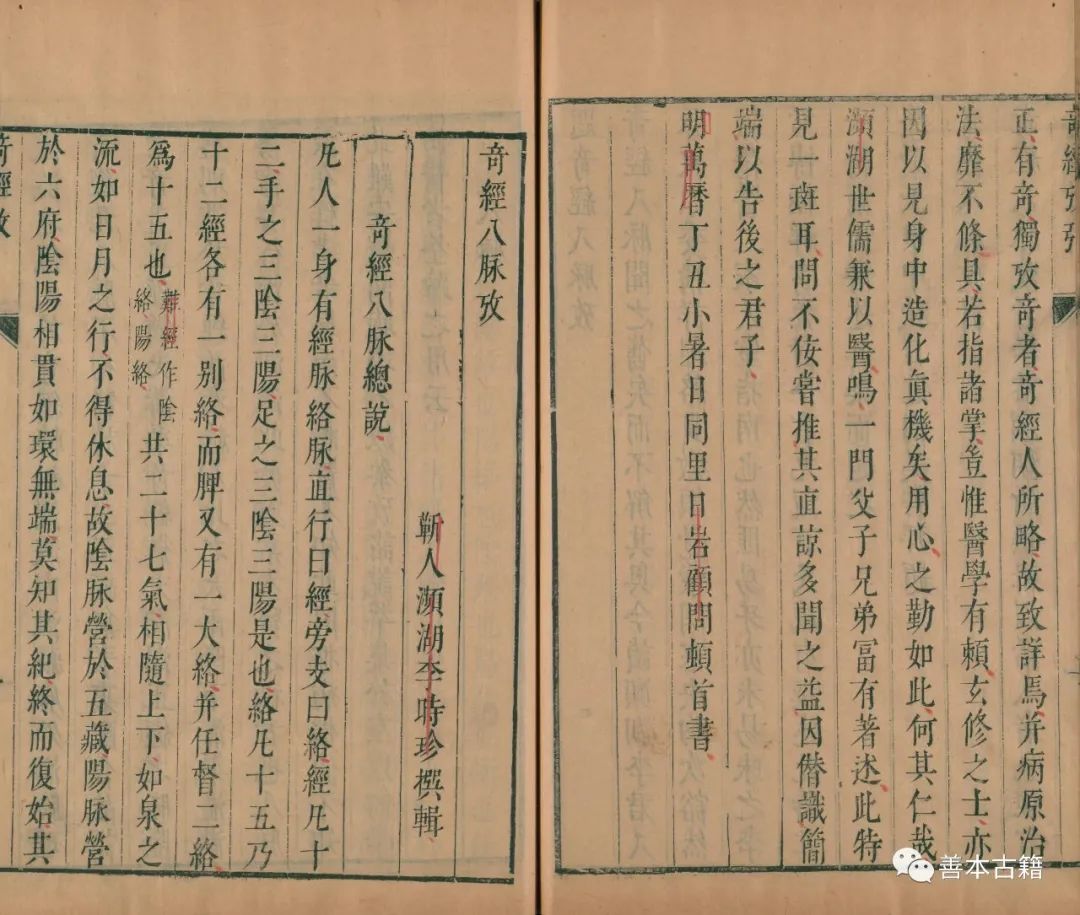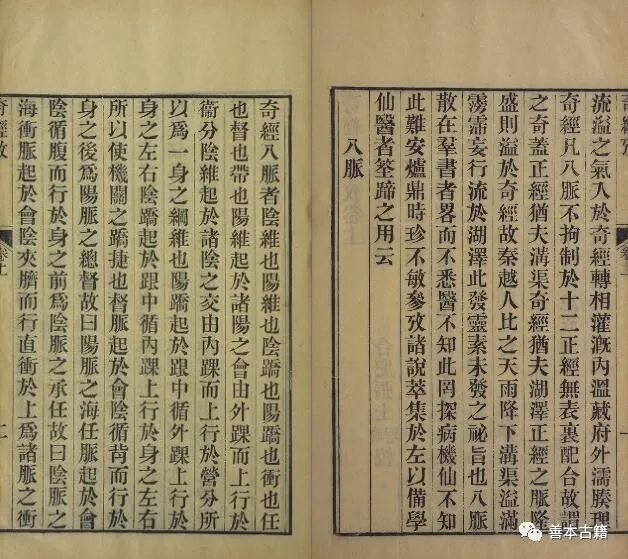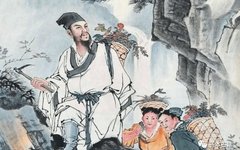
The “Study of the Eight Extraordinary Meridians” (奇经八脉考, Qí jīng bā mài kǎo), authored by Li Shizhen during the Ming Dynasty, is a specialized text discussing the eight extraordinary meridians. Li referenced historical literature to elucidate the principles of the “Inner Canon” (内经, Nèi jīng) and organized the pathways and therapeutic indications of the eight meridians: Yinwei (阴维, Yin Wei), Yangwei (阳维, Yang Wei), Yinqiao (阴跷, Yin Qiao), Yangqiao (阳跷, Yang Qiao), Ren (任, Ren), Du (督, Du), Dai (带, Dai), and Chong (冲, Chong). He provided corrections and personal insights, marking a significant development in the theory of meridians. 1. Author’s Biography and the Origin of the Work

Li Shizhen (1518-1593), styled Dongbi, later known as Binhushanren, was from Waxiangba in Qizhou (present-day Qichun County, Hubei). His grandfather was a physician, and his father, Li Yanwen, styled Ziyu, was a well-educated physician and a local renowned doctor who served as an official in the Imperial Medical Bureau. He authored works such as “Annotations on the Eight Meridians” (医学八脉注, Yīxué bā mài zhù) and “On the Four Examinations” (四诊发明, Sì zhěn fāmíng), which are now lost. Li Shizhen studied Confucianism in his youth but failed the provincial examinations three times. He studied under Gu Riyang for ten years. After being recommended, he served in the Imperial Medical Bureau, where he was said to have held the position of chief judge for only a year before resigning due to illness. In his later years, due to his son Li Jianzhong’s official position, he was promoted to Wenlin Lang and appointed as the magistrate of Pengxi County in Sichuan. Li Shizhen’s greatest achievement was his critique of the numerous errors in the annotations of the “Compendium of Materia Medica” (本草纲目, Běncǎo gāngmù). He conducted archaeological research to clarify doubts and errors, extensively collecting and compiling literature, and from the 31st year of the Jiajing era (1552) to the 6th year of the Wanli era (1578), he spent 27 years revising and completing the “Compendium of Materia Medica,” which consists of 52 volumes, divided into 16 sections and 62 categories, documenting 1892 medicinal substances, making it a monumental work of the Ming Dynasty. Li Shizhen also authored “Binhushan Pulse Studies” (濒湖脉学, Bīnhú mài xué) in 1564 and “Study of the Eight Extraordinary Meridians” in 1572. The former synthesizes the essence of previous pulse studies, simplifying and categorizing pulse patterns into 27 types, each accompanied by poetic descriptions; the latter elaborates extensively on the pathways and treatment principles of the extraordinary meridians. Other lost medical works include “Three Jiao Difficulties” (三焦客难, Sān jiāo kè nán), “Examination of the Mingmen” (命门考, Mìngmén kǎo), “Discussion on the Five Organs” (五脏图论, Wǔ zàng tú lùn), “Binhushan Medical Cases” (濒湖医案, Bīnhú yī àn), and “Binhushan Collected Simple Formulas” (濒湖集简方, Bīnhú jí jiǎn fāng). The origin of the “Study of the Eight Extraordinary Meridians” was Li Shizhen’s realization that, since the “Inner Canon” and “Nanjing” (难经, Nán jīng), although many physicians had researched the eight extraordinary meridians, the information was scattered across various texts and not comprehensively understood. Therefore, he meticulously verified and authored the “Study of the Eight Extraordinary Meridians,” adhering to the principles of the classics, drawing from various schools of thought, and integrating clinical practice to provide detailed verification, organization, and supplementation of the pathways and acupoints of the eight meridians, as well as elaborating on the methods of differential diagnosis and treatment. 2. Versions and Transmission of the “Study of the Eight Extraordinary Meridians”

The date of the completion and publication of the “Study of the Eight Extraordinary Meridians” can be inferred from the prefaces by Wu Zhe and Gu Riyang within the text. Wu’s preface states: “On the Mid-Autumn Day of the Year of Ren Shen during the Longqing era, Wu Zhe respectfully inscribed this,” indicating that it was written on the 15th day of the 8th lunar month in the 6th year of Longqing (1572), corresponding to September 21, 1572. Gu’s preface states: “On the Day of Lesser Heat in the Year of Ding Chou during the Wanli era, Gu Wen respectfully inscribed this,” which corresponds to the 12th day of the 6th lunar month in the 5th year of Wanli (1577), or June 27, 1577. Wu Zhe’s life details are unclear, while Gu Wen, named Riyang, was a Jinshi from Qizhou in the 17th year of Jiajing (1538) and served as a provincial official in Fujian. He returned home in the 4th year of Longqing (1570) and died in the 19th year of Wanli (1591). Li Shizhen often studied Neo-Confucianism with him. It is generally believed that Wu’s preface indicates the year the book was written, while Gu’s preface indicates the year it was published. Thus, the first publication of this book was in the 5th year of Wanli (1577), but this edition is no longer extant. After the completion of the “Study of the Eight Extraordinary Meridians,” it was published multiple times and widely circulated, with the following main categories of editions: 1. Standalone editions: Standalone editions of the “Study of the Eight Extraordinary Meridians” are rare. The Tianjin Municipal Library and Nantong Municipal Library have collections of Qing editions, while the Shanghai Traditional Chinese Medicine Literature Museum holds a 1912 stone-printed edition, and the China Academy of Chinese Medical Sciences Library has a 1970 Japanese reprint. 2. Supplementary editions: The most widely published version of the “Study of the Eight Extraordinary Meridians” is as a supplementary text to the “Compendium of Materia Medica.” The earliest edition of the “Compendium of Materia Medica” was published in the 18th year of Wanli (1590) by Hu Chenglong in Nanjing, without any supplements. In the 31st year of Wanli (1603), a vice-minister of the Jiangxi Provincial Court, Xia Liangxin, and the Jiangxi Inspector Zhang Dingsi raised funds to reprint the “Compendium of Materia Medica,” which included one volume each of the “Study of the Eight Extraordinary Meridians” and “Binhushan Pulse Studies.” This edition is known as the “Jiangxi Edition” or “Xia Liangxin Edition.” The inclusion of these two texts was facilitated by Li Shizhen’s fellow townsman, Yuan Jun, and Zhang Dingsi’s preface states: “I was instructed by Minister Xia to reprint the ‘Compendium of Materia Medica.’ The magistrate of Linchuan, Yuan Jun, a fellow townsman of Shizhen, also took his ‘Pulse Studies’ and ‘Study of the Eight Extraordinary Meridians’ to be included, as Li’s lifelong scholarly efforts were concentrated here, and I am fortunate to have them printed as a complete work.” This edition is the closest to the original text and has had a significant influence on later generations. Various editions from the late Ming to early Qing dynasties often used this as the base text. For example, the 34th year of Wanli (1606) edition by Xue Sancai and Yang Daohui in Jinjiang, the 13th year of Chongzhen (1640) edition by Qian Weiqi in Wulin, and various Qing editions based on this system. The 13th year of Chongzhen (1640) edition by Qian Weiqi in Wulin was reprinted based on the Jiangxi edition, with the title page stating: “Revised Compendium of Materia Medica, reprinted with thorough investigation, Wulin Qian’s edition.” The textual content, aside from minor errors and modifications from the Jiangxi edition, still represents a good version. Many Qing editions used this as the base text, such as the 12th year of Shunzhi (1655) edition by Wu Yuchang in Wulin, the 52nd year of Kangxi (1713) edition in Suzhou, and the Siku Quanshu edition during the Qianlong era, forming another system. In the 11th year of Guangxu (1885), Zhang Shaotang in Hefei reprinted based on Qian Weiqi’s edition, while also referencing the Nanjing edition, “Emergency Herb Materia Medica,” and “Illustrated Examination of Plant Names and Realities,” resulting in a finely carved and beautifully formatted edition that became the main version circulated after the late Qing. Most subsequent editions were reprinted based on this version, such as the 20th year of Guangxu (1894), 34th year (1908) Shanghai edition by Tujicheng Printing Bureau, and the 1957 People’s Health Publishing House reprint of the “Compendium of Materia Medica,” forming the Weigu Zhai system. The three major systems of the “Compendium of Materia Medica” primarily include the “Study of the Eight Extraordinary Meridians” as a supplementary text. Other reprints based on the Jiangxi edition, Wulin Qian edition, Hefei Zhang Shaotang edition, and other major versions all include the “Study of the Eight Extraordinary Meridians.” It was not until the 1975 People’s Health Publishing House published the corrected edition of the “Compendium of Materia Medica” that this book was no longer included. 3. Combined editions: The “Study of the Eight Extraordinary Meridians” is often combined with “Binhushan Pulse Studies” and “Pulse Theory Verification.” According to the “National Directory of Traditional Chinese Medicine Books,” the earliest known edition should be the 31st year of Wanli (1603) edition by Xia Liangxin and Zhang Dingsi, preserved in the Baizhan Building. There are still extant Ming and early Qing editions, as well as editions from the 9th year of Xianfeng (1859), the 5th year of Guangxu (1879) from Saoye Mountain House, the 5th year of Guangxu (1879) from Jiaojing Mountain House, the 9th year of Guangxu (1883) from Wencheng Hall in Kyoto, the 11th year of Guangxu (1885) from Hefei Zhang’s Weigu Zhai, the 22nd year of Guangxu (1896) from Wenzhifutang in Yangzhou, the 22nd year of Guangxu (1896) lead-printed edition from Tushujicheng Printing Bureau, the 31st year of Guangxu (1905) stone-printed edition from Shangxin Book Bureau, the Yigu Mountain House edition from the Mustard Seed Garden, the 1928 edition from Baowentang in Jiangyin, the 1951 lead-printed edition from Guangyi Book Bureau, and the 1954 and 1955 lead-printed editions from Shanghai Jinzhan Book Bureau, as well as the 1956 reprint from the People’s Health Publishing House, and the 1963 lead-printed edition from the People’s Health Publishing House. Additionally, in December 2007, the China Traditional Chinese Medicine Publishing House, and in January 2012 and May 2016, the China Medical Science and Technology Publishing House, respectively published combined editions of the “Study of the Eight Extraordinary Meridians” and “Binhushan Pulse Studies.” 4. Annotated editions: In recent years, scholars have gradually conducted research on the “Study of the Eight Extraordinary Meridians,” publishing annotated editions. For example, in January 1988, Guangdong Science and Technology Publishing House published “Research on the ‘Study of the Eight Extraordinary Meridians'” edited by Qian Yuanming, in February 1990, Shanghai Science and Technology Publishing House published an annotated edition by Wang Luozhen and Li Ding, reviewed by Li Chengzhi, and in August 2013, People’s Health Publishing House published “Annotations on the ‘Study of the Eight Extraordinary Meridians'” edited by Sun Chaozong and Sun Zhen. (Zhou Yixin)
If you wish to participate in discussions related to ancient texts, please reply to the WeChat public account with the message: Group Chat
Welcome to join the community for learning and exchanging knowledge about ancient texts.

